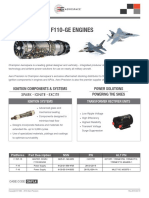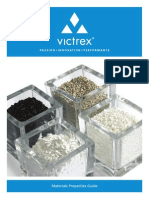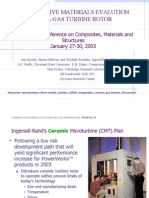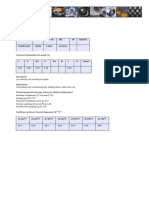0 ratings0% found this document useful (0 votes)
52 viewsSolubilizzazione MAR M-002
Solubilizzazione MAR M-002
Uploaded by
walkerbhoThis study examined the thermal stability of Ni-base superalloys representing conventional, directionally solidified, and single crystal castings. Microscopy, spectroscopy, and diffraction techniques were used to characterize changes in microstructure when aged specimens were exposed to 1000°C and 1100°C for up to 900 hours. Primary MC carbides were stable, but the strengthening y' phase experienced morphological and compositional changes including loss of coherency with the matrix and precipitation of sigma phase. Hardness initially decreased then increased, related to partial y' dissolution and sigma precipitation.
Copyright:
© All Rights Reserved
Available Formats
Download as PDF, TXT or read online from Scribd
Solubilizzazione MAR M-002
Solubilizzazione MAR M-002
Uploaded by
walkerbho0 ratings0% found this document useful (0 votes)
52 views2 pagesThis study examined the thermal stability of Ni-base superalloys representing conventional, directionally solidified, and single crystal castings. Microscopy, spectroscopy, and diffraction techniques were used to characterize changes in microstructure when aged specimens were exposed to 1000°C and 1100°C for up to 900 hours. Primary MC carbides were stable, but the strengthening y' phase experienced morphological and compositional changes including loss of coherency with the matrix and precipitation of sigma phase. Hardness initially decreased then increased, related to partial y' dissolution and sigma precipitation.
Original Description:
Superalloys
Copyright
© © All Rights Reserved
Available Formats
PDF, TXT or read online from Scribd
Share this document
Did you find this document useful?
Is this content inappropriate?
This study examined the thermal stability of Ni-base superalloys representing conventional, directionally solidified, and single crystal castings. Microscopy, spectroscopy, and diffraction techniques were used to characterize changes in microstructure when aged specimens were exposed to 1000°C and 1100°C for up to 900 hours. Primary MC carbides were stable, but the strengthening y' phase experienced morphological and compositional changes including loss of coherency with the matrix and precipitation of sigma phase. Hardness initially decreased then increased, related to partial y' dissolution and sigma precipitation.
Copyright:
© All Rights Reserved
Available Formats
Download as PDF, TXT or read online from Scribd
Download as pdf or txt
0 ratings0% found this document useful (0 votes)
52 views2 pagesSolubilizzazione MAR M-002
Solubilizzazione MAR M-002
Uploaded by
walkerbhoThis study examined the thermal stability of Ni-base superalloys representing conventional, directionally solidified, and single crystal castings. Microscopy, spectroscopy, and diffraction techniques were used to characterize changes in microstructure when aged specimens were exposed to 1000°C and 1100°C for up to 900 hours. Primary MC carbides were stable, but the strengthening y' phase experienced morphological and compositional changes including loss of coherency with the matrix and precipitation of sigma phase. Hardness initially decreased then increased, related to partial y' dissolution and sigma precipitation.
Copyright:
© All Rights Reserved
Available Formats
Download as PDF, TXT or read online from Scribd
Download as pdf or txt
You are on page 1of 2
JOURNAL OF MATERIALS SCIENCE 29 (1994) 2445-2458
Thermal stability of advanced Ni-base
superalloys
H. M. T A W A N C Y , N. M. A B B A S , A. I. A L - M A N A
Metrology, Standards and Materials Division, Research Institute, King Fahd University of
Petroleum and Minerals, PO Box 1639, Dhahran 31261, Saudi Arabia
T. N. R H Y S - J O N E S
Turbine Aerofoils Research and Development and Surface Technology, Rolls-Royce plc,
PO Box 31, Derby DE24 8B J, UK
Exposures consisting of 1 to 900 h at 1000 and 1100 ~ after an ageing treatment of 1 6 h at
870 ~ were used to study the thermal stability of selected y'-strengthened Ni-based
superalloys representing conventional, directional solidification, and single-crystal castings.
Various techniques of microscopy, spectroscopy and diffraction were used to characterize the
microstructure. Primary MC carbides in the alloys studied were found to be stable toward
decomposition into lower carbides. In the aged condition, the strengthening y' phase assumed
a cuboidal morphology; however, all alloys also contained varying proportions of coarse
lamellar y' and hyperfine cooling y'. On an atomic scale, the nature of the cuboidal y'-matrix
interface was found to vary from coherent to partially coherent. However, the overall lattice
mismatch varied from one alloy to another depending upon its composition and the
distribution of various elements in carbide phases and lamellar y' phase. Directional growth of
the cuboidal y' phase upon exposure to higher temperatures was found to be accelerated by a
large initial lattice mismatch leading to a considerable loss of coherency, as indicated by the
observation of dislocation networks around the y' particles. Although the composition of the
y' phase remained essentially unchanged, there was a marked change in matrix composition.
Sigma phase was found to precipitate in all alloys, but its thermal stability was a function of
alloy composition. The initial decrease in hardness followed by a hardening effect during
exposure could be explained in terms of the partial dissolution of the y' phase and
precipitation of sigma phase.
1, I n t r o d u c t i o n Extensive reviews have dealt with the mechanical
Although structural applications of ceramics, com- properties of the y' phase based upon the Ni3A1
posites and intermetallics in gas turbine engines may composition as well as y'-containing alloys [11, 12].
have potential for extending their temperature cap- Typically, the mechanical properties of y'-strength-
abilities [1], it is unlikely that these materials could ened alloys are evaluated after solution annealing, and
replace the superalloys at least in the foreseeable a standard ageing treatment designed to precipitate
future [2]. Improvements in engine thrust, fuel the strengthening y' phase. Subsequent prolonged ex-
consumption and durability continue to be largely posure to higher temperatures, however, ean cause
dependent upo n advances in superalloy technology as significant changes in the volume fraction and mor-
well as cooling systems. Advances in casting-alloy phology of the y' phase [13-19]. Misfit dislocations
development as well as the improvement in melting between the y' and y phases can form readily either
practices have significantly contributed to increasing during prolonged exposure to elevated temperatures
the temperature capabilities of Ni-base superalloys [13] or during plastic deformation [20, 21], resulting
strengthened by the Y' phase [3-6]. Directional solidi- in loss of coherency between the two phases. Other
fication [7, 8] and single-crystal castings [8] are important microstructural changes include precipit-
among the most important techniques developed to ation of topologically close-packed phases such as the
control the microstructure. In most advanced super- sigma phase [20, 21] and decomposition of primary
alloys, the strength of the Y' phase is optimized by ad- carbides [19, 22, 23].
ditions of Ti and Ta, and additional strengthening It was the objective of this investigation to study
of the matrix solid solution (Y phase) is provided by the thermal stability of selected Ni-base superalloys
additions of Mo, W and Re [9, 10]. representing three classes of castings: (i) conventional
0022-2461 9 1994 Chapman & Hall 2445
(Inconel alloy IN 100), (ii) directional solidification Specimens for light optical metallography were
(alloy MAR M 002 DS), and (iii) single crystal (alloys etched in Marble's reagent (10g copper sulphate,
RR 2000 and SRR 99)*. 50 ml HC1 and 50 ml H 2 0 ). As-polished specimens
were used for structural analysis by X-ray diffraction.
Thin-foil specimens for AEM experiments were pre-
2. Experimental procedure pared by the jet polishing technique in a solution
Table I summarizes the nominal chemical composi- consisting of 30% nitric acid in methanol at about
tions of the alloys investigated. As can be seen, alloy - 20 ~ All specimens were examined at 200 kV.
RR 2000 is essentially the single-crystal version of the
cast alloy IN 100 where grain-boundary strengthening
elements such as C, B and Zr are eliminated. Similarly, 3. Results and discussion
alloy SRR 99 is the single-crystal version of alloy 3.1. Microstructure in the aged condition
MAR M 002 DS. Fig. 1 illustrates light optical micrographs and X-ray
Specimens examined were in the form of rods about diffraction patterns derived from the alloys studied
20 mm in length and 8 mm in diameter. All specimens in the aged condition. Occasionally, voids typical of
were heat-treated for 1 h at 1100 ~ in argon atmo- cast metal products were observed, particularly in the
Sphere, air-cooled, aged for 16 h at 870~ in argon single-crystal alloys. All alloys contained MC carbides
and finally cooled in argon. Henceforth, this will be assuming script, cubic and/or semi-rounded morpho-
referred to as the aged condition. The mean blade logies. However, the cubic morphology was parti-
temperature during engine operation is usually about cularly pronounced in alloy MAR M 002 which could
900-1000 ~ but the temperature may locally rise to be related to the presence of Hf [24]; As expected, the
l l00~ due to hot-spot conditions. To cover this polycrystalline alloys (IN 100 and MAR M 002) con-
range, aged specimens were exposed for 1, 8, 24, 100, tained greater densities of MC carbides in compar-
500 and 900h at 1000 and l l00~ to study the ison with their single-crystal versions (RR 2000 and
thermal stability of each alloy. SRR 99).
Light optical metallography, scanning electron In addition to reflections of the matrix (y phase,
microscopy (SEM) and the transmission electron face-centred cubic solid solution), all diffraction pat-
microscopy (TEM) mode of an analytical electron terns contained characteristic superlattice reflections
microscope (AEM) were used to characterize the of the y' phase (L12 supeflattice, face-centred cubic)
microstructure. Structural analysis was conducted by such as the (1 00) and (1 1 0) as shown in Fig. 1. Since
X-ray diffraction using CuK~ radiation. Energy- and the volume fraction of carbide phases in each alloy
wavelength-dispersive X-ray spectroscopy (EDXS was less than about 10%, no carbide reflections were
and WDXS, respectively) were used to determine the observed. As shown in Fig. la, alloy IN 100 had
microchemical composition of bulk specimens in the a random grain orientation; however, because of
SEM. Also, EDXS employing an ultra-thin window the relatively small diameter of the X-ray beam in
detector was used to determine the microchemical comparison with grain size, the intensities of some
composition of thin-foil specimens in the scanning reflections were unusually high. For the directionally
transmission electron microscopy (STEM) mode of an solidified alloy MAR M 002 and the single-crystal
AEM. alloys RR 2000 and SRR 99, the (2 0 0) reflections were
the most intense, reflecting the normal ( 1 0 0 ) growth
T A B L E I Nominal chemical compositions of the alloys studied direction [25].
For all alloys studied, the y' phase assumed three
Element Composition (wt %) distinct morphologies: (i) lamellar, (ii) cuboidal and
(iii) spherical, but the cuboidal morphology was
IN 100 RR 2000 MAR M SRR 99
002 DS
predominant. Coarse lamellar y' was particularly ob-
served near the surface as shown in Fig. 2. Evidently,
Cr 9.5 10 9 8.5 this form of y' had formed during solidification and
A1 5.5 5.5 5.5 5.5 could not be completely redissolved during solution
Ti 4.75 4 1.5 2.2
annealing [25]. Because of the 75-100~ higher
Co 15 15 10 5
Mo 3 3 0.5" 0.5"
melting range of the single-crystal alloys in compar-
W 0.2" 0.5 a 10 9.5 ison with the polycrystalline versions, they contained
Ta - 0.05" 2.5 2.8 greater proportions of lamellar y'.
Hf - 0.05 a 1.25 0.05" Fig. 3 illustrates the cuboidal y' phase providing the
V 0.95 1 - -
main source of mechanical strength and which had
Zr 0.95 0.0P 0.055 0.0P
Fe 1~ 0.1a 0.5 a 0.1 a
formed during thermal ageing. All alloys studied con-
B 0.015 - 0.015 - tained about the same volume fraction of cuboidal
C 0.175 0.015 0.15 0.015 y' (68-70%), estimated metallographically using the
Ni Bal. Bal. Bal. Bal. point counting method [26]. The average particle size
ranged from about 0.32 gm in alloy SRR 99 to 0.63 ~tm
a Maximum. in alloy IN 100. Such a range of particle size is
* Inconel is a registered trademark of the Inco family of companies, MA R M is a registered trademark of Martin Marietta Corporation, while
SRR and RR are registered trademarks of Rolls-Royce plc.
2446
You might also like
- BMS Commissining ChecklistDocument52 pagesBMS Commissining ChecklistAnvay Patil100% (2)
- Calculation of The Crosshead Velocity Required To Achieve A Specified Stress Rate or An Estimated Strain RateDocument9 pagesCalculation of The Crosshead Velocity Required To Achieve A Specified Stress Rate or An Estimated Strain Ratemp87_ing100% (2)
- Sri Govinda-Damodara Stotram San-Eng PDFDocument13 pagesSri Govinda-Damodara Stotram San-Eng PDFaldairlucasNo ratings yet
- Champion F15 F16 F110Document2 pagesChampion F15 F16 F110adrianioantoma100% (1)
- GE Advance Material and CoatingDocument30 pagesGE Advance Material and Coatingkhunplatt100% (1)
- J %ijki: 400 Commonwealth Drive Warrendale, Pa 1S096Document14 pagesJ %ijki: 400 Commonwealth Drive Warrendale, Pa 1S096KaradiasNo ratings yet
- ASTM E2658 Standard Practices For Verification of Speed For Material Tetsign MachinesDocument10 pagesASTM E2658 Standard Practices For Verification of Speed For Material Tetsign MachineswalkerbhoNo ratings yet
- NIS ElementsDocument245 pagesNIS ElementswalkerbhoNo ratings yet
- Food PoisoningDocument24 pagesFood PoisoningSena AjahNo ratings yet
- Alloy IndexDocument105 pagesAlloy IndexPeñaloz GustavoNo ratings yet
- SAE AMS5699 - RevGDocument8 pagesSAE AMS5699 - RevGLynn AlgerNo ratings yet
- GE Adv Gas Turb Mats and Coatings Ger3569gDocument30 pagesGE Adv Gas Turb Mats and Coatings Ger3569gjcarella_1100% (1)
- JEGTP 1980 Vol 102 N1Document228 pagesJEGTP 1980 Vol 102 N1kangsungjinNo ratings yet
- Victrex - Material Properties Guide 3 - 7 - USDocument26 pagesVictrex - Material Properties Guide 3 - 7 - USBakkiya RajNo ratings yet
- Jet EnginesDocument34 pagesJet EnginesTerassopaspartu100% (1)
- Ge LMS100Document18 pagesGe LMS100cyyguy3kNo ratings yet
- Application of Alloy 718 in GE Aircraft Engines PDFDocument12 pagesApplication of Alloy 718 in GE Aircraft Engines PDFReyhan EfNo ratings yet
- Imece2014 38164 PDFDocument9 pagesImece2014 38164 PDFYemane TesfayeNo ratings yet
- Prevention of Corrosion by PaintDocument37 pagesPrevention of Corrosion by PaintSanjib DekaNo ratings yet
- IR Comparitive Materials Evaluation For Gas Turbine Kesseli Et AlDocument37 pagesIR Comparitive Materials Evaluation For Gas Turbine Kesseli Et AlRizwan MNo ratings yet
- Axial Turbine Rim SealingDocument22 pagesAxial Turbine Rim SealingOsman ParlakNo ratings yet
- A Brief History: Development of Single Crystal SuperalloysDocument5 pagesA Brief History: Development of Single Crystal SuperalloysKaanMertNo ratings yet
- Aluminide Coating:: 1) Low Activity High Temperature (LAHT)Document5 pagesAluminide Coating:: 1) Low Activity High Temperature (LAHT)Raza AliNo ratings yet
- Gek50336 Illustrated Parts BreakdownDocument1,096 pagesGek50336 Illustrated Parts BreakdowneceballosmsuNo ratings yet
- Additive Manufacturing TechniqueDocument29 pagesAdditive Manufacturing Techniquejohn kasichNo ratings yet
- Protection and Condition Monitoring of The LM5000 Gas TurbineDocument9 pagesProtection and Condition Monitoring of The LM5000 Gas TurbineSudeshNo ratings yet
- Performance of Axial Compressor StagesDocument11 pagesPerformance of Axial Compressor StagesBiswajit Jena100% (1)
- JEGTP 1983 Vol 105 N4Document242 pagesJEGTP 1983 Vol 105 N4kangsungjinNo ratings yet
- 1 1 PDFDocument74 pages1 1 PDFAbigor45No ratings yet
- g3616 A4 Lehw0198 FinalDocument4 pagesg3616 A4 Lehw0198 FinalVictor Nunez100% (1)
- Fouling Preventive CoatingsDocument3 pagesFouling Preventive CoatingsAnonymous PkeI8e84RsNo ratings yet
- Off FlowassuraDocument1 pageOff FlowassuraDavid CHazteloNo ratings yet
- Rolls-Royce Trent - WikipediaDocument1 pageRolls-Royce Trent - WikipediaMohammedAhabNo ratings yet
- O-AER10303 Gas Turbine - LM6000 Level 1 Maintenance 5 DaysDocument4 pagesO-AER10303 Gas Turbine - LM6000 Level 1 Maintenance 5 DaysDaniel MoralesNo ratings yet
- TurbineDocument11 pagesTurbineSureshbabu ThamburajNo ratings yet
- I A G T C: Ndustrial Pplication OF AS Urbines OmmitteeDocument13 pagesI A G T C: Ndustrial Pplication OF AS Urbines Ommittee'Izzad Afif100% (1)
- Mechanical Properties of Carbon Fiber Composite MaterialsDocument2 pagesMechanical Properties of Carbon Fiber Composite MaterialsmehtabpathanNo ratings yet
- 3013 PDFDocument42 pages3013 PDFOlbira Dufera100% (1)
- Muskeg Cabinet ListsDocument20 pagesMuskeg Cabinet ListsAnkit Patel100% (1)
- Advantages of Aeroderivatives IAGT 206 - Final - PaperDocument15 pagesAdvantages of Aeroderivatives IAGT 206 - Final - PapermvanzijpNo ratings yet
- NLR Rapport Over Corrosie NH-90Document138 pagesNLR Rapport Over Corrosie NH-90RaulMesaNo ratings yet
- GeneratorDocument9 pagesGeneratorSooraj Surendran SugathaNo ratings yet
- Development of 1.5-Million Pound Thrust M-1 Liquid Hydrogen/Oxygen Rocket EngineDocument406 pagesDevelopment of 1.5-Million Pound Thrust M-1 Liquid Hydrogen/Oxygen Rocket EngineDwayne Day100% (2)
- Teledyne CAE J402 - WikipediaDocument5 pagesTeledyne CAE J402 - WikipediaMorgen Gump100% (1)
- Boeing Phantom Works ObogsDocument13 pagesBoeing Phantom Works ObogsYJanitorNo ratings yet
- AMTE 214-2B Fail Safe: Submitted By: Rodriguez, John Mark MDocument6 pagesAMTE 214-2B Fail Safe: Submitted By: Rodriguez, John Mark MJohn Mark RodriguezNo ratings yet
- Technical Trend of Aircraft BearingsDocument5 pagesTechnical Trend of Aircraft BearingsnrNo ratings yet
- NASA CR-2005-213584 - Vol - 1 PDFDocument330 pagesNASA CR-2005-213584 - Vol - 1 PDFmaurizio.desio4992No ratings yet
- Repairing Gas Turbine EnginesDocument2 pagesRepairing Gas Turbine EnginesGustavo Palacios100% (1)
- Marine Gas Turbine: PerformanceDocument2 pagesMarine Gas Turbine: PerformanceFederico PinnaNo ratings yet
- Schafrik History of Mtls in Jet Engines 1Document63 pagesSchafrik History of Mtls in Jet Engines 1Rahul SrivastavaNo ratings yet
- AeroBrochure-final Turbine BladeDocument9 pagesAeroBrochure-final Turbine BladekksonkNo ratings yet
- Yttria-Stabilized Zirconia Thermal Barrier Coatings - A ReviewDocument10 pagesYttria-Stabilized Zirconia Thermal Barrier Coatings - A ReviewycwbycwbNo ratings yet
- TF100-53B 3900 Series QD CouplingsDocument6 pagesTF100-53B 3900 Series QD Couplingsrrrr100% (1)
- 02 FIRE - Causation, Preventin, Protection & FightingDocument20 pages02 FIRE - Causation, Preventin, Protection & FightingOladimeji TaiwoNo ratings yet
- AGARD AG-298 Manual On Aeroelasticity in Axial Flow Turbomachines Volume 1Document286 pagesAGARD AG-298 Manual On Aeroelasticity in Axial Flow Turbomachines Volume 1Ömer TanrıkuluNo ratings yet
- Qin2015 Article CorrosionBehaviorOfTheFrictionDocument12 pagesQin2015 Article CorrosionBehaviorOfTheFrictionDilipSinghNo ratings yet
- InTech-Recrystallization of Dispersion Strengthened Copper AlloysDocument21 pagesInTech-Recrystallization of Dispersion Strengthened Copper AlloysbinkinNo ratings yet
- Microstructural Evolution During Thermomechanical. Processing of Alloy 625Document12 pagesMicrostructural Evolution During Thermomechanical. Processing of Alloy 625esteban.cuevasNo ratings yet
- Fletcher 2005Document7 pagesFletcher 2005Vidyadhara VNo ratings yet
- A Study On The Formation of Smectite in Silica Scales Precipitated From GeothermalDocument4 pagesA Study On The Formation of Smectite in Silica Scales Precipitated From GeothermalAhmed AwadNo ratings yet
- Characterization and Catalytic Performance of Mesoporous Molecular Sieves Al-MCM-41 MaterialsDocument6 pagesCharacterization and Catalytic Performance of Mesoporous Molecular Sieves Al-MCM-41 MaterialsIsraelPala-RosasNo ratings yet
- Assessment of Hardness in As-Cast and Homogenized Zn-Al-Cu AlloysDocument4 pagesAssessment of Hardness in As-Cast and Homogenized Zn-Al-Cu AlloysJ WakeNo ratings yet
- #10.1007_s11661-006-1078-7_jwvdDocument14 pages#10.1007_s11661-006-1078-7_jwvdAbbas EslamiNo ratings yet
- EffectoftheMolybdenumontheMicrostructuralandMechanicalPropertiesofHadfieldAusteniticDocument7 pagesEffectoftheMolybdenumontheMicrostructuralandMechanicalPropertiesofHadfieldAusteniticAnisur RahamanNo ratings yet
- Texture-Governed Electrochemical Corrosion Behaviour of AA 6082 AlloyDocument16 pagesTexture-Governed Electrochemical Corrosion Behaviour of AA 6082 AlloyBasim Al-bhadleNo ratings yet
- Evaluation of Uncertainty in Determining Average Grain Size by ASTM E112 StandardDocument9 pagesEvaluation of Uncertainty in Determining Average Grain Size by ASTM E112 StandardwalkerbhoNo ratings yet
- Wide Gap Brazing When Parts Don't Fit Together Well For BrazingDocument2 pagesWide Gap Brazing When Parts Don't Fit Together Well For BrazingwalkerbhoNo ratings yet
- Niobium To Stainless Steel Braze Transition DevelopmentDocument3 pagesNiobium To Stainless Steel Braze Transition DevelopmentwalkerbhoNo ratings yet
- Hot Mounting: - Fast Mounting - Superior Edge Retention - Optimal PlanenessDocument6 pagesHot Mounting: - Fast Mounting - Superior Edge Retention - Optimal PlanenesswalkerbhoNo ratings yet
- Effect of Si Addition As A Grain RefinerDocument12 pagesEffect of Si Addition As A Grain RefinerwalkerbhoNo ratings yet
- Improving Repair Qualitv of Turbine Nozzles Using SA650 Braze AlloyDocument8 pagesImproving Repair Qualitv of Turbine Nozzles Using SA650 Braze AlloywalkerbhoNo ratings yet
- Mechanical Preparation of MaterialsDocument11 pagesMechanical Preparation of MaterialswalkerbhoNo ratings yet
- Al 7075Document11 pagesAl 7075walkerbhoNo ratings yet
- STF87114 Flyer STF87F 01-11Document1 pageSTF87114 Flyer STF87F 01-11walkerbhoNo ratings yet
- SIHARD 2243 Steel: Designation by StandardsDocument3 pagesSIHARD 2243 Steel: Designation by StandardswalkerbhoNo ratings yet
- Ti Metastable DiagramDocument1 pageTi Metastable DiagramwalkerbhoNo ratings yet
- Disclosure To Promote The Right To InformationDocument16 pagesDisclosure To Promote The Right To InformationwalkerbhoNo ratings yet
- GB Grade EmatiiDocument2 pagesGB Grade EmatiiwalkerbhoNo ratings yet
- Vickers Hardness CalculatorDocument2 pagesVickers Hardness CalculatorwalkerbhoNo ratings yet
- United States Patent (10) Patent N0.2 US 7,740,724 B2Document4 pagesUnited States Patent (10) Patent N0.2 US 7,740,724 B2walkerbhoNo ratings yet
- Hydrogen in Titanium AlloysDocument56 pagesHydrogen in Titanium AlloyswalkerbhoNo ratings yet
- HFICDocument2 pagesHFICwalkerbhoNo ratings yet
- MA200 Instruction Manual PDFDocument107 pagesMA200 Instruction Manual PDFwalkerbhoNo ratings yet
- Lubricant and Coolant Recommendations: B 00525 - 7 en 0507 / SVB 1Document30 pagesLubricant and Coolant Recommendations: B 00525 - 7 en 0507 / SVB 1AnbarasanNo ratings yet
- Eng 10 Diagnostic 2015Document7 pagesEng 10 Diagnostic 2015api-300424583100% (2)
- Checklist Reticuloendothelial System ExaminationDocument5 pagesChecklist Reticuloendothelial System Examinationmohammed alrubaiaanNo ratings yet
- MICROBIOLOGICALDocument6 pagesMICROBIOLOGICALRainMan75No ratings yet
- 2020 DNB AnesthesiaDocument33 pages2020 DNB AnesthesiasreesaichowdaryNo ratings yet
- Hair Analysis - The Whole Story, Not QuackWatch'sDocument28 pagesHair Analysis - The Whole Story, Not QuackWatch'sGary Moller100% (3)
- 16 Del Pilar Academy Vs Del Pilar Academy Employees UnionDocument2 pages16 Del Pilar Academy Vs Del Pilar Academy Employees UnionMichael Gargantiel Carneo100% (1)
- Operating Manual: LKHP Pump For High Inlet PressureDocument24 pagesOperating Manual: LKHP Pump For High Inlet Pressurepablo ortizNo ratings yet
- The Feasibility of Oregano ExtractDocument26 pagesThe Feasibility of Oregano ExtractVince RJ SilvestreNo ratings yet
- Smart PV Controller: SUN2000-33KTL-ADocument2 pagesSmart PV Controller: SUN2000-33KTL-ALucas NascimentoNo ratings yet
- 18196Document4 pages18196RianNo ratings yet
- Art TherapyDocument1 pageArt TherapyAMERA GUMAMANo ratings yet
- Modicon M580: Hardware Reference ManualDocument398 pagesModicon M580: Hardware Reference ManualJoão Paulo Falci BarbosaNo ratings yet
- Healthcaredeliveryconcerns ORIGINALDocument46 pagesHealthcaredeliveryconcerns ORIGINALrockyNo ratings yet
- General Psychiatry Case Form: Add Extra Pages Where Ever NecessaryDocument8 pagesGeneral Psychiatry Case Form: Add Extra Pages Where Ever NecessarySofia nazeerNo ratings yet
- NR-210803-Material and Energy BalanceDocument8 pagesNR-210803-Material and Energy BalanceSrinivasa Rao G100% (1)
- Item Bank Science Class 6Document104 pagesItem Bank Science Class 6Share LayNo ratings yet
- Course Syllabus in Criminalistics 6 I. Course Title Lie Detection II. Course DescriptionDocument16 pagesCourse Syllabus in Criminalistics 6 I. Course Title Lie Detection II. Course DescriptionVanessa Omnas Padilla100% (6)
- Tourniquet Evaluation On Perfused CadaversDocument5 pagesTourniquet Evaluation On Perfused CadaversJean CotteNo ratings yet
- Thermal Power Plant Diagram All You Need To Know About ItDocument7 pagesThermal Power Plant Diagram All You Need To Know About Itngoc hoangNo ratings yet
- .Post Distribution Monitoring Report Final 1Document28 pages.Post Distribution Monitoring Report Final 1Ibrahim Mohamed IbrahimNo ratings yet
- Grundfosliterature 6206216Document40 pagesGrundfosliterature 6206216marvkasNo ratings yet
- V-Diaries 2013 - Sonia T. DelenDocument16 pagesV-Diaries 2013 - Sonia T. DelenFilipina Women's Network100% (1)
- Marketing Straight To The HeartDocument232 pagesMarketing Straight To The HeartMirela EftimieNo ratings yet
- Linking Words IELTSDocument6 pagesLinking Words IELTSshiblu39No ratings yet
- Tyfo Wr-Afp: For The Tyfo CFP SystemDocument2 pagesTyfo Wr-Afp: For The Tyfo CFP SystemAlan Said AbdulrahmanNo ratings yet
- Low Value Grant Proposal: Annex - 2Document3 pagesLow Value Grant Proposal: Annex - 2Agung TriyandiNo ratings yet














































































































